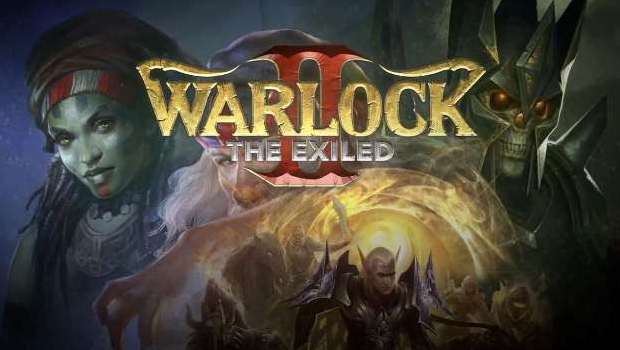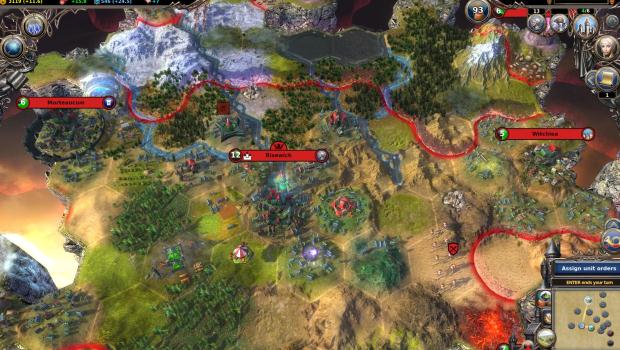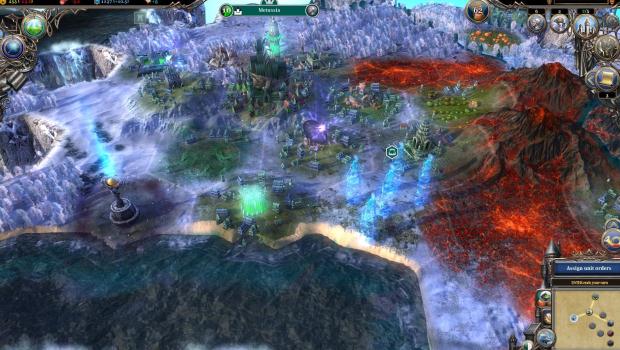My dark army was crushing everything in it’s path. Skeleton soldiers, with a few minor upgrades, had led the charge against the only wizard I had come across during my travels across worlds. This small front was only a taste of what was to come, because behind these undead soldiers approached a force my opponent could not handle. Two units of minotaurs and a hungry pack of werewolves were in transit to the opposing warlocks lands. That long wait before my devastating trio of mass destruction was killing me though. My skeletons were fine, but just whittling down the cities’ health. I still had half a dozen movements before my backup would be there, which may feel like a few minutes, but then the silence was broken. My children were getting hungry, so I had to stop my assault. For now.
Much like the famed Civilization series, Paradox Interactive’s latest turn-based offering Warlock II: The Exiled, does a wonderful job at digging its claws into the player and making them forget about time all together. Warlock II: The Exiled spins Civilization V-esque gameplay into a high-fantasy setting, and throws in a few other neat tricks for good measure. The most notable, beside the setting itself, is the option to scatter your travels from one world to many. The default setting will have you bouncing from world to world via portals, each locked with a small quest. I don’t recall the specific amount of worlds in my first game (on the default settings for a large map), but each one had a flavor of its own. The last one I came across before bowing out in defeat, rather chalking it up to a learning game, was a Hell-inspired world complete with powerful demons that ended up taking down my most powerful units.
As a long time Civilization player, it was easy for me to fall into line with Warlock II. After wrapping my poor head around jumping through portals to travel between worlds, everything was starting to feel like second nature. There were some limitations, though, which put a damper on my kingdom-ruling plans. I’m used to building cities at an exponential rate in the beginning, but, as a budding warlock, my ruling capabilities were limited to six major instances for building. I could create free cities, and a few variables, which just gave me a small amount of tax money, but unless I spent research points on upgrading my ruling capacity, I was nailed into a small amount of cities. It’s worth noting, I prefer to play on large maps, so this would not be a problem for those that play on normal or smaller maps. Even so, I adjusted, and enjoyed my game time very much. This was a slight distraction, but nothing more.
City improvements can only be built every 1,000 peoples in any given city. Again, on larger maps, when things are spread out, I had a hard time managing my resources to accommodate my small but fierce army. After a few learning games in piecemeal format, this wasn’t as much of an obstacle for my forceful army. The amount of resources my army gobbled up, whether it was mana or money, seemed like a more significant amount compared to what I was used to. Thankfully, Warlock II has a lot more than just a few enemy empires to throw at the player.
A good portion of every game I played was spent battling neutral forces, some in small camps and some in small cities. This kept my games fresh and kept me on my game. There’s a stark difference in battling a neutral enemy and another warlock. Random monsters were a great resource for money and mana, and didn’t put up too much resistance.
Another thing that sets warlocks apart from neutral powers are their spell books. Instead of researching technology, I had a bunch of spells to research, some being offensive, others defensive, and then a few which pertained to my kingdom in general. Towards the end of the game, as long as I had enough mana I could manipulate the lands in all sorts of ways, summon massive beasts, or hurl fireballs and lightning at my enemies. I was satisfied with my minotaur army, but making the sky rain fire on a cluster of enemies always made me smile.
I played with a few different races, to sample their units and building structures, but even in the first game I got a good sampling of said-units. The undead were my favorite; with their skeletons, it just felt more natural wreaking havoc on everything. But after capturing a human city, I had access to the human race options in the captured city.
Warlock II: The Exiled is a beautiful and colorful game, with an addictive quality that made gaming me lose track of time on multiple occasions during my gaming sessions. At a glance, Warlock II gives the impression it is simply a fantasy version of Civilization, but after dipping your toes in it, you’ll quickly realize the water is deeper than it appears.


